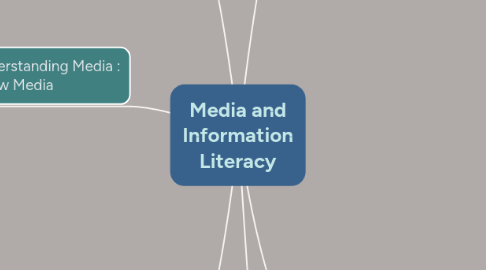
1. LESSON 1 : What is Media?
1.1. Media
1.1.1. To spread the information to others
1.1.2. Helps improve the way we communicate with other people
1.1.3. The Communication Process
1.1.3.1. Source
1.1.3.2. Message
1.1.3.3. Channel
1.1.3.4. Receiver
1.1.4. The Feedback Mechanism
1.1.5. Information Industry
1.1.6. Culture of Entertainment
1.2. Kinds of Media
1.2.1. Traditional Media
1.2.1.1. Invented prior to the invention of the Internet
1.2.1.2. Broadcast Media
1.2.1.3. Film or Cinema
1.2.1.4. Mass Media
1.2.2. New Media
1.2.2.1. Media that developed when the use of computer technology
1.2.3. Social Media
1.2.3.1. Internet-maintained computer programs
1.2.4. Mobile Communications Technology
1.2.4.1. Smartphones
1.2.5. Related and Emerging Technologies
1.2.5.1. Any kind of home entertainment gaming console that uses similar ICT systems
2. LESSON 2 : Media Then and Now
2.1. History of Media
2.1.1. Pre Industrial Age
2.1.1.1. Oral traditions
2.1.2. Industrial Age
2.1.2.1. Technology advances
2.1.3. Electronic Age
2.1.3.1. Gadgetry and devices
2.1.4. Digital Age
2.1.4.1. Current age
2.2. Brief History of Philippine Media
2.2.1. Pre - Colonial Traces
2.2.2. The Print Industry and Filipino Freedom
2.2.3. The European Film Import
2.2.4. The Broadcast Industry
2.2.5. Local Online Media
2.3. The State of Media Today
2.3.1. From Globalization to Glocalization
2.3.2. The Local Landscape
2.4. Media Ownership
2.4.1. Mainstream Media
2.4.1.1. Commercial-run type of media businesses characterized by the corporate structure of business.
2.4.2. Alternative and Independent Media
2.4.2.1. The other choice for the existing mainstream media
2.4.3. Community Media
2.4.3.1. Any form of media that is created and controlled by a community
2.4.4. Stated-owned Media
2.4.4.1. The government owns and controls specific media outlets
3. LESSON 3: Understanding Media : Aesthetics of the Media, Text, and Audio
3.1. Framing and Reading
3.1.1. Photography and Timeless Image Concepts
3.1.2. Newspapers and Journalism
3.1.3. Books, Comics, Magazines, and the Publishing Industry
3.2. Framing and Listening
3.2.1. Radio and Evoking Imagination
4. LESSON 4 : Understanding Media : Aesthetic of Film and Tv
4.1. The Film Form
4.1.1. Modes of Film Production
4.1.2. Film Formats
4.1.2.1. Doocumentary
4.1.2.2. Narrative
4.1.2.3. Animation
4.1.2.4. Experimental
4.1.3. Film Image Composition
4.1.4. Motion Framing Concepts
4.2. The Tv Broadcast - it has more stable and unending supply of content.
4.2.1. Kinds of Tv Shows -Informative Programming, Entertainment Programming
4.2.2. Tv Show Anatomy and Advertising
4.3. Craft Media Messages
4.3.1. Creating Meaning in Audio Production
4.3.2. Creating Meaning in Image Production
4.3.3. Creating Meaning in Audiovisual Production
5. LESSON 6 : Understanding Media: Aesthetics of Social Networking
5.1. Deeper Understanding of Social Media
5.1.1. What is Social Networking? A supportive sysem of sharing information and services.
5.2. Relevance of Social Media in Today's Society
5.2.1. Personal Communications
5.2.2. Business and Customer Care Tools
5.2.3. Social Services and Governance
5.2.4. Educational Tools
5.2.5. Advocacy Campaigns
5.2.6. Traditional Media Coverage and Social Media Enhancement
5.2.7. Entertainment Portals
6. LESSON 5 :Understanding Media : Aesthetic of New Media
6.1. Deconstructing New Media
6.1.1. New Media Technology : Covergence and Characteristics
6.1.2. New Media as Multimedia
6.1.3. New Media Transitions: from Synergy to Transmedia
6.2. Intersecting Traditional Media and New Media
6.2.1. Journalism + Internet = Blogging
6.2.2. Broadcasting = Internet = Podcast
6.2.3. Film = Internet = Youtube
